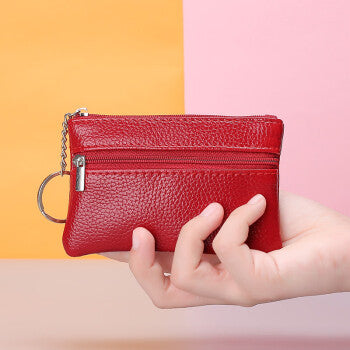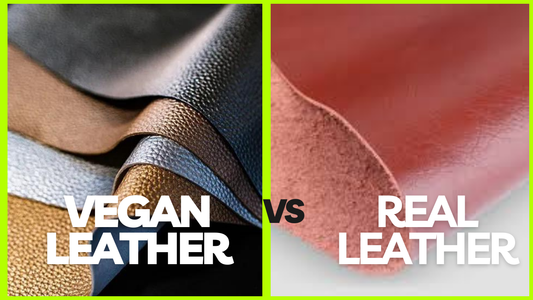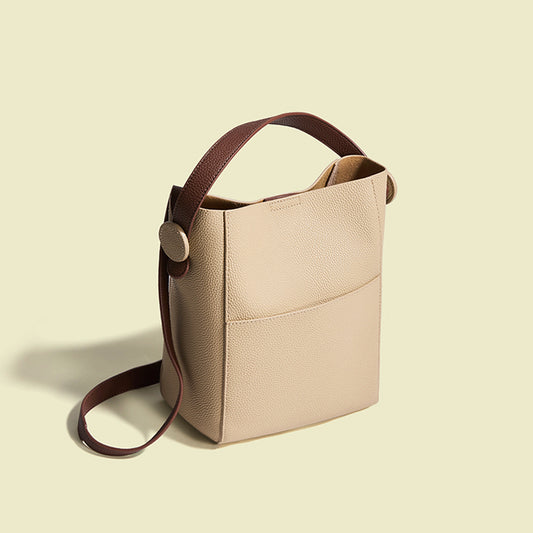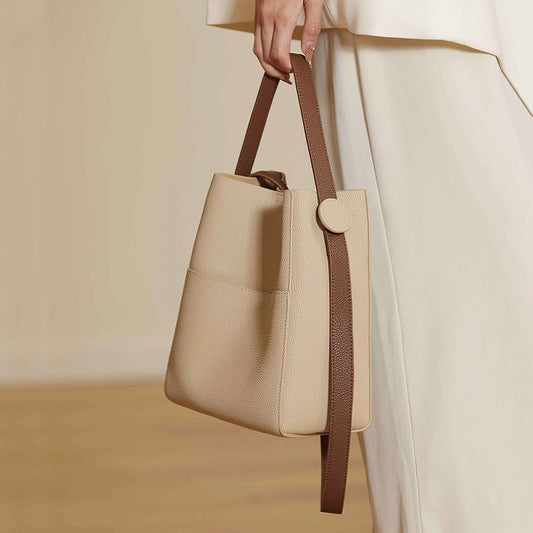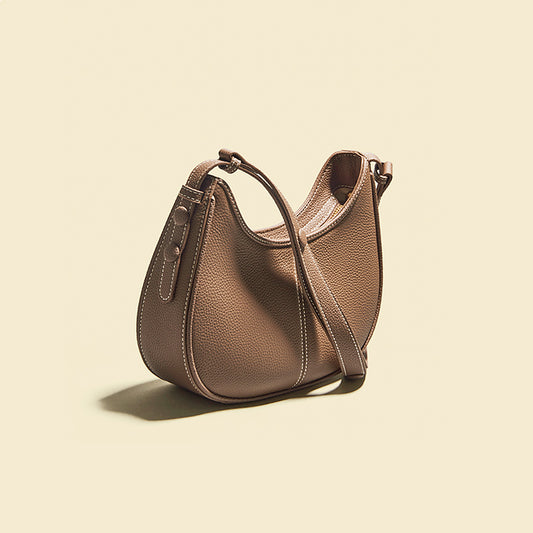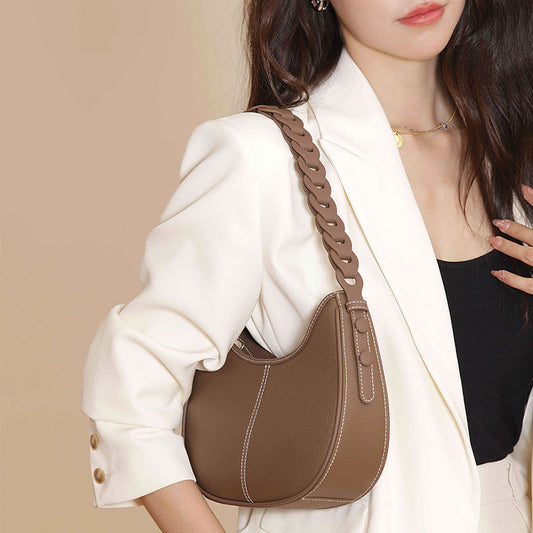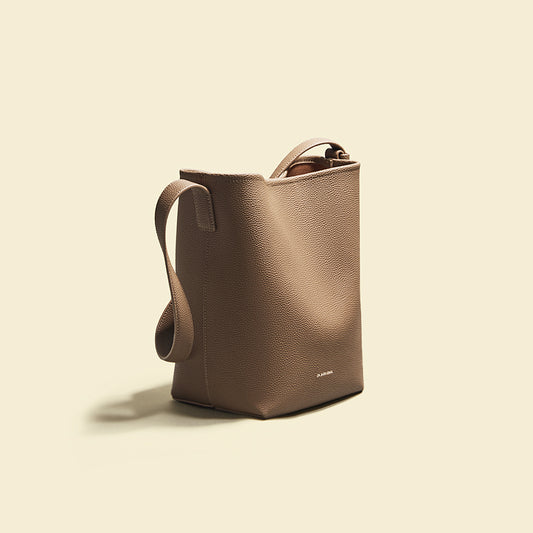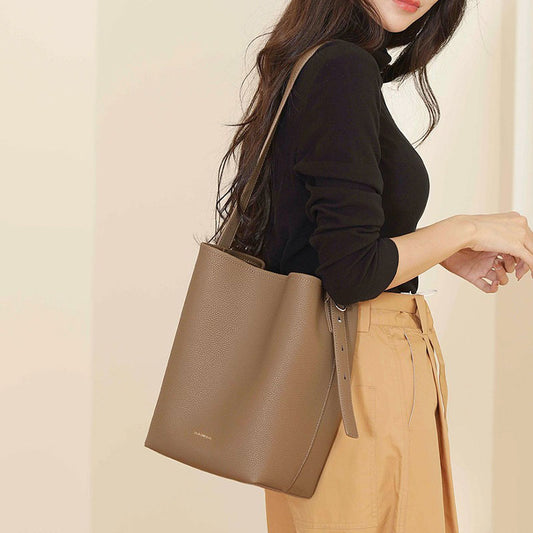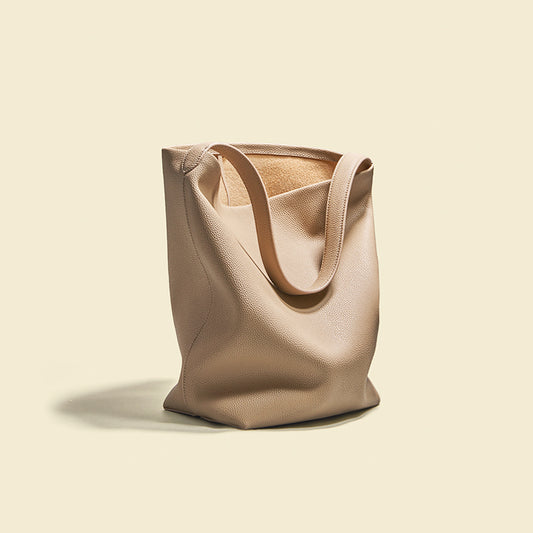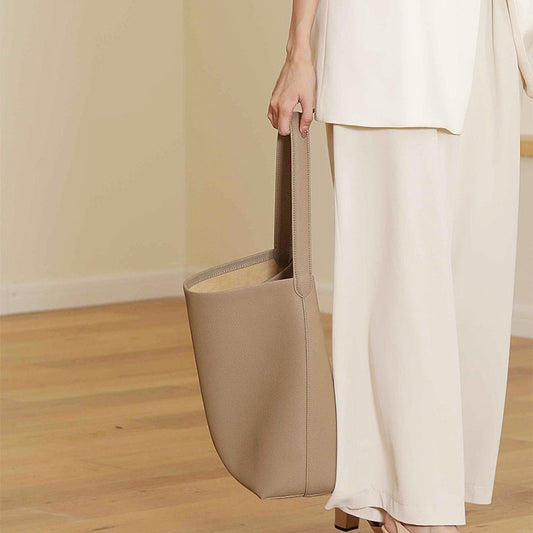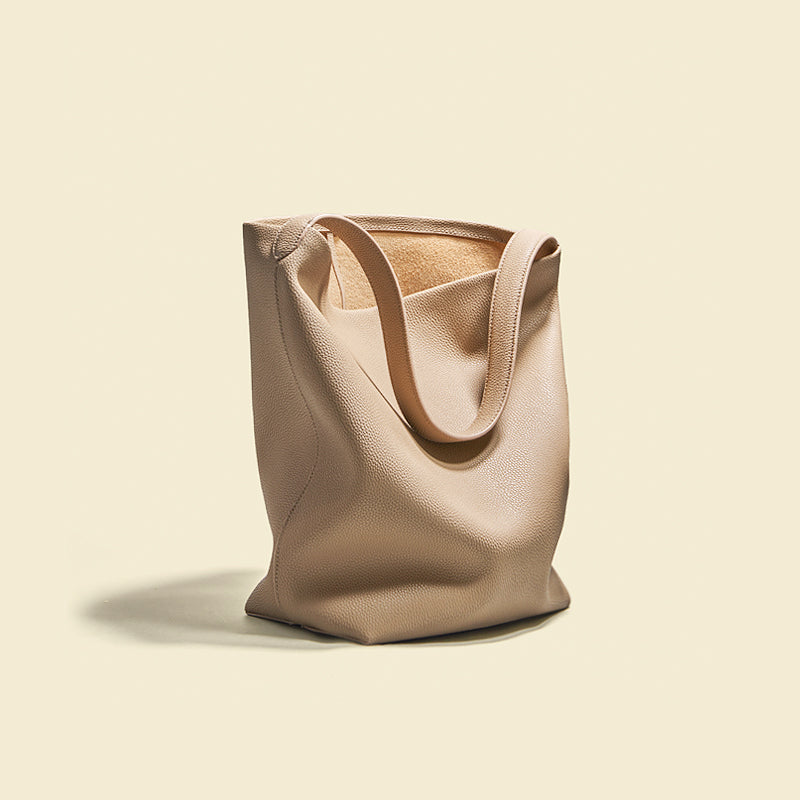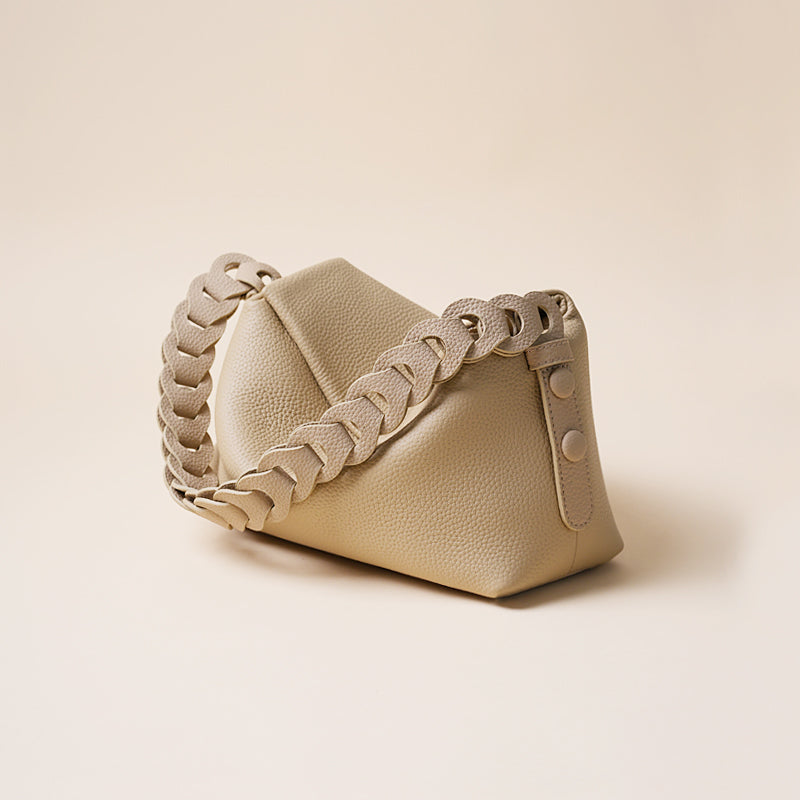Introduction
Full-grain leather is often hailed as the pinnacle of leather quality, making it a popular choice for various luxury items, including bags, shoes, and furniture. This guide aims to provide a comprehensive overview of Full Grain Leather, its characteristics, benefits, and why it stands out among other leather types. Understanding Full Grain Leather, especially when considering products like Full Grain Leather bags, can help you make informed purchasing decisions and maintain your leather goods effectively.
What Is Full-grain Leather?
Full-grain leather, which is derived from the top layer of the hide, is the best leather currently on the market. This layer provides a distinctive and genuine look by preserving the original grain and flaws. Since full grain leather isn't sanded or polished to hide imperfections, it is tougher and more resilient than other leathers.
Full-grain Leather's Key Characteristics:
- Natural Grain: The surface has the original grain pattern, showcasing the hide's natural beauty.
- Durability: Due to its strength, full-grain leather can withstand heavy use and last for many years.
- Patina Development: Full Grain Leather has a deep patina that improves its look with time.
Full Grain Leather Comparison with 100% Leather:
While "100% leather" can refer to any leather product, it doesn't guarantee the quality or type. Full-grain leather is a specific type of 100% leather that represents the highest quality and durability, setting it apart from other leather types.
Why Are Full Grain Leather Bags So Popular?
Full Grain Leather bags are particularly sought after for several reasons:
- Aesthetic Appeal: The natural grain and patina development give these bags a timeless and sophisticated look.
- Longevity: The durability of Full Grain Leather ensures that the bags can handle daily wear and tear while maintaining their integrity.
- Distinctive Character: The inherent differences in the skin give each full-grain leather bag a distinct look, rendering each item distinctive.
What Does Full Grain Leather Look Like?
Full-grain leather has a distinctive appearance, characterized by its natural grain and imperfections. These features include visible pores, scars, and variations in color, which contribute to its unique aesthetic.
- Natural Grain: Visible patterns and textures that indicate the hide's original surface.
- Scars and Marks: Natural imperfections that add character and authenticity.
- Color Variations: Subtle differences in shade that occur naturally.
How It Feels:
- Texture: Slightly rough and uneven due to the unaltered grain.
- Firmness: Typically firmer and stiffer compared to other leather types, which softens with use.
Where Does Full Grain Leather Come From?
Cattle provide the top layer of the hide, which is used to make full-grain leather. This layer is highly valued due to its resilience and robustness. High-quality Grain Leather is often sourced from regions known for their exceptional cattle, such as Italy, the United States, and South America.
How is Full Grain Leather Made?
The production process of Full Grain Leather involves several key steps:
- Selection: High-quality hides are selected for their minimal imperfections.
- Tanning: To preserve the leather and increase its longevity, the hides are subjected to a tanning process, most often vegetable or chrome tanning.
- Finishing: Unlike other leather types, full-grain leather undergoes minimal processing. It is dyed and treated to retain its natural characteristics without sanding or buffing.
Craftsmanship in Grain Leather Bags
Creating full-grain leather bags requires skilled craftsmanship. Each bag is meticulously crafted to highlight the leather's natural beauty and ensure durability. The process involves cutting, stitching, and assembling the leather with precision, often incorporating traditional techniques that have been refined over generations.
Types of Full Grain Leather Finishes
Full-grain leather can be treated in various ways to create different finishes, each with unique characteristics and applications. Understanding these finishes is essential, especially when choosing the right full-grain leather bag that suits your style and needs.
Pebbled Leather:
Definition: Pebbled Leather is a type of Full Grain Leather that has been treated to create a raised, pebble-like texture on its surface. Usually, a tumble procedure is used to do this during the finishing phase.
Uses:
- Bags: Popular in handbags and briefcases due to their textured, stylish appearance.
- Accessories: Frequently used in wallets, belts, and small leather goods for added grip and visual interest.
Advantages:
- Durability: The textured surface is more resistant to scratches and wear.
- Aesthetic Appeal: Offers a unique look that stands out from smooth leather.
Burnished Leather:
Definition: Burnished Leather is full-grain leather that has been polished to create a slightly glossy finish. This process enhances the leather's natural characteristics, giving it a more refined look.
Uses:
- Bags: Common in luxury handbags and satchels, providing an elegant, polished appearance.
- Footwear: Often used in high-end shoes and boots for a sophisticated finish.
Advantages:
- Enhanced Beauty: The burnishing process highlights the leather's natural grain and imperfections.
- Refined Look: Ideal for formal accessories and apparel.
Oiled Full Grain Leather:
Definition: Oiled Grain Leather is treated with oils to make it more supple and water-resistant. This finish gives the leather a slightly darker, richer color.
Uses:
- Bags: Suitable for rugged, outdoor bags and casual everyday carry items.
- Footwear: Common in work boots and outdoor shoes for enhanced durability.
Advantages:
- Water Resistance: Its oil treatment helps it ward off moisture, which makes it perfect for outdoor use.
- Softness: The leather becomes more flexible and comfortable with use.
Care Tips:
- Regular Oiling: Apply a suitable leather conditioner or oil to maintain suppleness and water resistance.
- Avoid Excessive Moisture: While more resistant, prolonged exposure to water can still damage the leather.
Tumbled Full Grain Leather:
Definition: Tumbled Grain Leather is tumbled in a drum to soften it and enhance its natural grain. This process results in a more pliable and textured leather.
Uses:
- Bags: Perfect for casual bags and backpacks that require flexibility and comfort.
- Clothing: Often used in jackets and vests for a relaxed, broken-in feel.
Advantages:
- Softness: The leather becomes softer and more pleasant to wear or carry as a result of the tumble process.
- Unique Texture: Each piece has a distinct texture, adding to its individuality.
Maintenance Tips:
- Since full grain leather isn't sanded or polished to hide imperfections, it is tougher and more resilient than other leathers.
- Store Properly: Avoid folding or compressing to maintain its natural shape and texture.
Which Leather Is the Highest Quality?
Because of its inherent strength, resilience, and beauty, full-grain leather is frequently regarded as the best kind of leather.
Factors Contributing to Quality:
- Source: The best Grain Leather typically comes from regions with high standards for cattle rearing, such as Italy and the United States.
- Tanning Procedure: Because vegetable tanning is environmentally friendly and produces a deep patina, it is frequently used for premium leather.
How Long Does Full Grain Leather Last?
Full-grain leather may last a lifetime with proper care.
Its durability is unmatched, making it a preferred choice for items that endure regular use, such as bags, belts, and shoes.
Longevity Factors:
- Maintenance: Regular conditioning and cleaning extend the lifespan.
- Usage: Even with heavy use, Full Grain Leather retains its strength and often looks better with age due to the patina development.
Thickness of Full Grain Leather
Depending on how it will be used, grain leather might have different thicknesses. For instance, leather used in bags may be thicker to provide structure and durability. In contrast, leather used in clothing might be thinner for comfort.
Typical Thickness:
- Bags: Often range from 1.2 to 2.2 millimeters.
- Clothing: Usually thinner, ranging from 0.8 to 1.4 millimeters.
Advantages of Full Grain Leather:
• Durability: renowned for its robustness and resilience to abrasion.
• Aesthetic Appeal: Over time, it acquires a distinctive patina that enhances its attractiveness.
• Breathability: Prevents the accumulation of moisture by allowing air to move through.
• Eco-Friendly: Full-grain leather tanned using vegetables is eco-friendly.
Cons and Difficulties
• Price: Because of its superior quality, it is usually more costly.
• Maintenance: Regular attention is required to maintain its robustness and appeal.
• Weight: Compared to other varieties of leather, it might be heavier, making it appropriate for fewer applications.
Is Full Grain Leather Expensive?
Full-grain leather is indeed an expensive endeavor. Its high caliber, robustness, and the artistry that went into its creation are all reflected in its price.
Comparisons with Other Leathers
Understanding how Full Grain Leather compares to other types of leather is essential for making informed purchasing decisions. Each type of leather has its unique characteristics, benefits, and drawbacks, which make them suitable for different uses.
Full Grain Leather vs. Corrected Leather
Definition:
- Full Grain Leather: Consists of the entire natural grain and is crafted from the uppermost layer of the hide.
- Corrected Leather: Has the top surface sanded and buffed to remove imperfections, often coated with an artificial grain to give it a uniform look.
Key Differences:
- Appearance: Full-grain leather has a natural, unique appearance with visible grain and imperfections, whereas Corrected Leather has a more uniform and artificial look.
- Maintenance: Regular attention is required to maintain its robustness and appeal.Corrected Leather is less durable due to the removal of the natural grain and may age less gracefully.
- Use Cases: Full-grain leather is ideal for high-end products like luxury bags, wallets, and shoes, while Corrected Leather is often used in lower-cost goods.
Full Grain Leather vs. Top Grain Leather vs. Split Leather
Definitions:
- Full Grain: The finest leather, sliced from the hide's outermost layer
- Top Grain Leather: Constructed from the uppermost layer, then refined and sanded to eliminate flaws.
- Split Leather: Made from the lower layers of the hide, often finished with a coating to mimic the look of higher-quality leather.
Key Differences:
Full grain leather is the highest quality and most durable, with top grain leather coming in second. The least durable type of leather is split.
• Aesthetics: Full-grain leather acquires a patina and keeps its original texture. Top Grain Leather appears more consistent. Split leather frequently has a synthetic sheen.
• Cost: The most costly type of leather is full grain, which is followed by top grain and split leather.
Special Leather Grades
Understanding leather grades can help you identify the best-quality products. Leather is often graded based on the tanning process and the quality of the hide.
Explanation of 1000-Grade Leather
Definition:
- 1000-grade leather is a marketing term and does not have a standardized meaning. It often implies high-quality, premium leather, but specifics can vary by manufacturer.
Explanation of Grade 7000 Leather
Definition:
- Similar to 1000 grade, grade 7000 leather is a marketing term. It usually suggests a very high quality of leather but lacks standardization.
The Most Expensive and Durable Leather Qualities
Top Choices: Full-grain leather:
The most expensive due to its quality, durability, and natural beauty.
Care and Maintenance
The lifespan and beauty of Full Grain Leather items, especially Full Grain Leather purses, depend heavily on proper upkeep and care. Insights from leather tanners, artisans, and professional cleaners can provide a comprehensive understanding of how to maintain your leather goods best.
How to Maintain Full Grain Leather
Regular conditioning and cleaning are necessary for maintaining full-grain leather. This keeps the leather looking good, keeps it from cracking, and keeps it supple.
Conditioning:
To maintain the leather supple and hydrated, use a premium leather conditioner every few months.
- Apply the conditioner in a circular motion with a gentle cloth to allow it to seep into the leather.
- Before buffing off any excess, let the conditioner lie for a few hours or overnight.
Avoid Direct Sunlight and Heat:
- Prolonged exposure to sunlight and heat can dry out and fade the leather.
- Keep your leather products out of direct sunlight in a cool, dry environment.
- Regular use helps develop a natural patina and keeps the leather flexible.
- Avoid overloading leather bags to maintain their shape and structure.
Protection Tips for Full Grain Leather
Protecting full-grain leather from environmental damage and everyday wear can significantly extend its life.
- Water Protection: To build a barrier against moisture, use a water-repellent spray or leather protectant.
- Reapply the protectant regularly, especially after cleaning or conditioning.
- Managing Spills: Immediately dab spills using a fresh, dry towel.
- Don't rub since this may cause the stain to spread.
- Storage: To keep leather bags free from dust and scuffs, keep them in dust bags while not in use.
- Avoid using plastic bags since they have the potential to absorb moisture and cause mildew.
- Preventing Scratches: Keep leather away from rough surfaces and sharp items.
- Use a leather balm to minimize the appearance of minor scratches.
Conclusion
In conclusion, This guide will help you understand the difference between Full Grain Leather and other leather types, learn how to properly care for and maintain Full Grain Leather products,
Whether you're in the market for a durable Full Grain Leather bag, a stylish pair of shoes, or a luxurious wallet, knowing the intricacies of Full Grain Leather can help you choose the perfect product to suit your needs and preferences.
Additional Resources


